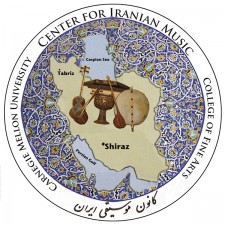Musical History
Achaemenian Empire (550-331 BC)
Scant information from Greek sources about Zoroastrian rituals and the military instrument. Two instruments may have survived from this ancient time:
Karnây: a large double reed instrument like a long oboe (kar=war, nay=reed).
Surnây: smaller oboe type instrument still used in Iran (sur=feast, nay=reed).
Seleucid Empire (312-63 B.C)
Parthian Empire (248 B.C-224 A.D)
Not much information about the musical practice of these two Empires has survived. We know that both were much influenced by Hellenic culture.
Sassanian Empire (224-642 A.D):
Music had a high place at the Sassanian courts especially at the court of Khosro II (called Khosro Parviz) who ruled from 590 to 628 AD. Numerous stories about the musicians of this king’s court have survived. Also names of many court musicians have survived. One of the most important court musician was Bârbad. He is attributed to have created a musical system called the Dástân system. This system consisted of:
– Seven Royal Modes, called Khosrovâni.
– Thirty drivative modes, called Lahn.
– Three hundred and sixty melodies called Dástân.
We do not know what these modes and melodies were, but a number of their names have been related by the writers of the medieval Islamic era.
Arab Invasion and the Islamic Empire (642- 1258)
Some musicologists believe that the Dástân system was spread by Persian musicians throughout the vast Islamic empire. Especially during the Abbasid Dynasty (750-1258) as well as during the regional autonomous rulers across the North Africa, Southern Spain, North Persia, and Central Asia.
A confluence of the Persian system and the regional musical traditions gave birth to a new system called the Maqâm.
Maqâm became an international musical system throughout a vast area that stretched from southern Spain all the way to the border of China and lasted from the 8th until the 16th century.
The medieval time was the height of the development of science, philosophy, and the arts of the Middle Eastern civilizations.
Names of great medieval musicians and music scholars (please see pages 4-5 of the Farhat’s book):
Persian pronunciation Arabic pronunciation Latin pronunciation
Ebrâhim Museli (742-803) Al Museli _______
Eshâgh Museli (766-849) Al Museli _______
Abu Nasr Fârâbi (872-950) Al Fârâbi Alfarabius
Abdolfaraj Esfahâni (896-966) Al Isfâhâni _______
Abu Ali Pour Sinâ (980-1037) Ibn Sinâ Avicenna
(or Ebne Sinâ)
Safiaddin Ormavi (1216-1294) Al Urmawi ________
Qotnaddin Shirâzi (1236-1312) Al Shirazi ________
Abdolqâder Marâghi (died 1435) Al Marâghi ________
Some of the important medieval music manuscripts:
The Great Book of Music by Fârâbi (written in 10th century).
The Book of Cycles by Ormavi (written in 12th century).
The Musical Encyclopedia by Shirâzi (written in 13th century).
The Complete Treatises of Music by Marâghi (written in 15th century).
The Safavi Empire (1502-1736)
Clashes between the Safavi and the Ottoman empires. Separation of Iranian music from Arabic and Turkish music.
The Qâjâr Dynasty (1794-1925)
The evolution of the Dástgâh system. Development of the court music at the courts of the Qâjâr kings.
The completion of the Dástgâh system and the evolution of the Radif (traditional music repertoire attributed to a master).
Names of great musicians of early 19th century:
The Farahâni Family:
Ali-Akbar Farahâni (died 1855). Great 19th century musician and the father of Mirza-Abdollah and Mirza Hoseingholi.
Mirza Abdollah (1843 – 1918) and Mirza Hoseingholi (1854 – 1916). Sons of Farahâni, great musicians of 19th and early 20th century. Important founders of the Persian traditional music repertoire, the Radif.
The Pahlavi Dynasty (1925-1979)
Influence of western music. Westernization of the Iranian traditional music.
Names of important musicians of early 20th century:
Ali Naghi Vaziri (1887-1979). Founder of the modern school of thought in Persian traditional music. He was an ardent supporter of westernization of Persian music. However, many of Vaziri’s theories have been disputed and rejected after the 1979 revolution.
Ruhollah Khâleghi (1906-1965). The founder and the first director of the National Conservatory of Music in Tehran.

